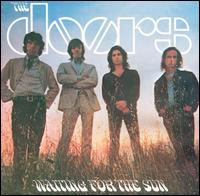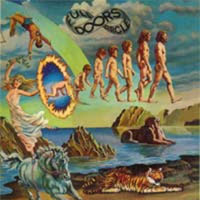Features
Strange Days Indeed
The Doors Albums Ranked Best to Worst
by David Bowling
The Doors’ career burned brightly for five years and then died along with Jim Morrison. The band held on for a couple of years after, but the magic was gone. With Jim Morrison, the band only released six studio albums during their existence. Add in two post-Morrison albums and one that was cobbled together in 1978 and you have a total of nine studio albums from a band that left a lasting legacy on rock music.
There are five albums that that are virtually interchangeable. Depending on my mood, any of them could be ranked number one. What is certain is that the first six studio albums by The Doors are the equal to just about any first six releases by any band or artist before or since.
1. L.A. Woman (1972)
The last of the Doors studio albums, L.A. Woman found them moving in new directions. While they always projected the dark side of rock and roll, songs like “Riders On The Storm” were downright ominous. Add in “Crawling Snake King” and “The Changling” and you have the foundation of a sinister album. Even the catchy “Love Her Madly” travels an almost perverse journey. Over four decades after its release, I am still discovering new textures. It may not be the most enjoyable Doors album, but it is definitely the most interesting.
 2. The Soft Parade (1969)
2. The Soft Parade (1969)
This is an album that is often overlooked. The band filled out their music with some brass and strings, adding some blues and jazz elements to their sound, but all in all, it remains a rock and roll album and one of the better ones of its era. Interestingly, the album’s best songs were all written by Robbie Krieger solo. The powerful “Touch Me,” the ominous “Wishful Sinful,” the jazzy “Runnin’ Blue,” and the rocking “Tell All The People” are testament to the fact that the Doors were not just Jim Morrison.
3. The Doors (1967)
When examining the Doors catalogue, the easiest thing to do is put their debut album at number one and move on. I think the passage of time has anesthetized me to the brilliance of their first album, though. Side one of the original release is one of the strongest of the vinyl era. “Break On Through,” “Soul Kitchen,” “The Crystal Ship,” “Alabama Song (Whiskey Song),” “Twentieth Century Fox,” and the long version of “Light My Fire” are cohesive and connected. The 11-minute “The End,” which is the album’s last track, took on new life when it was included in the film Apocalypse Now. Now, it is forever connected to the Vietnam War.
 4. Waiting For The Sun (1968)
4. Waiting For The Sun (1968)
“Hello I Love You” and “Five To One” are both brilliant and bookend the label. “The Unknown Soldier” is one of the unforgiving protest songs of the time period and it is amazing it received any mainstream radio airplay at the time. Throw in “Love Street,” “Spanish Caravan,” and the monochromatic “We Could Be So Good Togther” and you have another strong outing.
5. Morrison Hotel (1970)
Not as cohesive as the four albums listed above it, but some of the individual parts are excellent as stand-alone songs. “Peace Frog” has a quirky cadence with biting lyrics and has my vote as one of the great underappreciated Doors songs. “Roadhouse Blues” and “You Make Me Real” contain powerful vocals by Morrison. Through in a recycled “Waiting For The Sun” and you have an effective mix of styles and sounds.
 6. Strange Days (1967)
6. Strange Days (1967)
Strange Days suffered from the fact that it followed their brilliant first album and so there was a degree of disappointment at the time. Looking back over the decades, it remains the weakest of their first six releases, but it still contains some of the best material of its era. “People Are Strange” and “Love Me Two Times” were the beginning of the Doors trending toward a darker tone to their music. At nearly 11 minutes, “When The Music’s Over” may not be the match of the equally long “The End,” but it does demand your attention.
7. Other Voices (1971)
There is a severe decline in the quality of the first six albums and what followed. Jim Morrison was dead and Ray Manzarek, John Densmore, and Robby Krieger regrouped to issue the appropriately named Other Voices. At the time, I remember having hope that the Doors would continue as a competent, if not upper echelon band. The album is average, but songs like “In The Eye Of The Sun,” “Tightrope Ride,” “Ship W/ Sails,” and “Variety Is The Spice Of Life” are very listenable. The only thing that holds this album back is the lack of Jim Morrison’s voice.
 8. An American Prayer (1978)
8. An American Prayer (1978)
A controversial album in its day. The three remaining Doors reunited to record backing music for some of Morrison’s poetry. Many of Morrison’s supporters were not pleased with the concept or the final result. It is an album where the music and lyrics are at odds with each other. Just because you can doesn’t mean you should. It does prove the eternal appeal of the Doors as it sold over one million copies.
9. Full Circle (1972)
It is difficult to imagine a worse album than An American Prayer, but the 1972 Doors managed to issue one of the worst albums by a major band during the 1970s. “The Mosquito” and “Piano Bird” struggled to be average and they were by far the best of a bad lot. It makes one think that Morrison left some ideas behind for Other Voices because on their own, the three remaining band members created a real stinker.